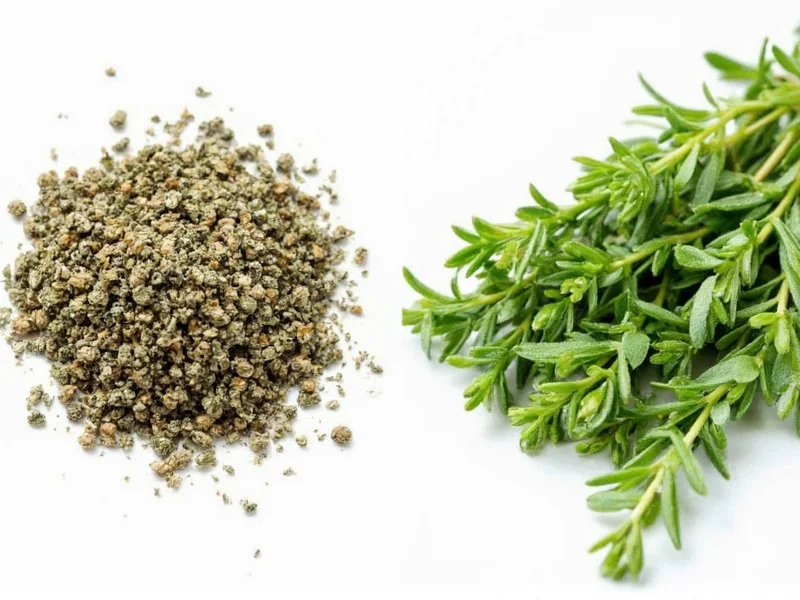Understanding the Fundamental Differences Between Dried and Fresh Thyme
When comparing dried vs fresh thyme, the most significant difference lies in their flavor concentration and moisture content. Fresh thyme contains approximately 85% water, which evaporates during the drying process, resulting in dried thyme being about three times more potent. This concentration difference directly impacts how you should use each form in your cooking.
Flavor Profile Comparison
Fresh thyme delivers bright, grassy notes with subtle floral undertones and a slight minty finish. The flavor is more nuanced and delicate, making it perfect for dishes where you want the herb to complement rather than dominate. Dried thyme, by contrast, develops deeper, more earthy characteristics with intensified woody notes. The drying process concentrates certain compounds while diminishing others, creating a more robust but less complex flavor profile.
Chef Marco Pierre White notes that “Dried herbs capture the essence but lose the subtlety of fresh counterparts.” This observation holds particularly true for thyme, which contains volatile oils that partially dissipate during drying.
Precise Substitution Guidelines
Understanding dried thyme vs fresh thyme substitution ratios is crucial for recipe success. The standard conversion is:
| Fresh Thyme | Dried Thyme Equivalent | Best Used In |
|---|---|---|
| 1 tablespoon | 1 teaspoon | Finishing dishes, salads, quick-cooking recipes |
| 3 tablespoons | 1 tablespoon | Long-simmering dishes, braises, stews |
| 1/4 cup | 1.5 tablespoons | Rub mixtures, marinades, compound butters |
When substituting dried thyme for fresh in recipes, add it earlier in the cooking process to allow time for rehydration and flavor development. For the reverse substitution (fresh for dried), add fresh thyme toward the end of cooking to preserve its delicate flavors.
Culinary Applications: When to Use Each Form
Certain cooking techniques and dishes benefit from one form over the other. Understanding these applications represents one of the most practical aspects of dried thyme vs fresh thyme comparison.
Best Uses for Fresh Thyme
- Finishing sauces and soups just before serving
- Salads and cold preparations where texture matters
- Compound butters for immediate use
- Infusing oils and vinegars
- Dishes with short cooking times (less than 20 minutes)
Best Uses for Dried Thyme
- Long-simmering stews, braises, and stocks (2+ hours)
- Dry rubs for meats and vegetables
- Baking applications like breads and savory pastries
- Spice blends and seasoning mixes
- Dishes where visual appearance of fresh herbs would be undesirable
Storage and Shelf Life Considerations
Proper storage significantly impacts the quality of both forms. Fresh thyme maintains peak quality for 10-14 days when stored correctly in the refrigerator. Wrap the stems in a slightly damp paper towel and place in a perforated plastic bag. For extended storage, freeze fresh thyme sprigs in olive oil cubes.
Dried thyme retains optimal flavor for 6-12 months when stored in an airtight container away from light and heat. After one year, dried thyme doesn't spoil but gradually loses potency. To test dried thyme quality, rub a small amount between your fingers—if it doesn't release a strong aroma, it's time to replace it.
Nutritional Differences
While both forms offer similar nutritional profiles, fresh thyme contains slightly higher levels of vitamin C and certain volatile compounds. Dried thyme, due to its concentrated nature, provides more thymol (the primary active compound) per volume. A study published in the Journal of Agricultural and Food Chemistry found that drying thyme increases the concentration of certain antioxidants while reducing others.
For culinary purposes rather than medicinal applications, these nutritional differences rarely impact cooking decisions. The flavor and practical considerations typically outweigh minor nutritional variations when choosing between dried vs fresh thyme.
Common Mistakes to Avoid
Many home cooks make these errors when working with thyme:
- Incorrect substitution ratios - Using equal volumes instead of adjusting for potency differences
- Adding dried thyme too late - Not allowing enough time for rehydration in long-cooking dishes
- Using old dried thyme - Not realizing degraded dried herbs won't deliver expected flavor
- Over-processing fresh thyme - Chopping too finely and releasing bitter compounds
- Ignoring stem quality - Using woody, thick stems in dishes where they'll be noticeable
Practical Tips for Maximizing Flavor
For dried thyme: Bloom it in warm oil or toast it briefly in a dry pan before use to release maximum flavor. For fresh thyme: Strip leaves from thicker stems but leave smaller, tender stems intact as they're edible and flavorful. When substituting dried thyme for fresh in recipes, consider adding a pinch of lemon zest to mimic fresh thyme's brighter notes.
Professional chefs often employ a hybrid approach—using dried thyme early in the cooking process for foundational flavor and fresh thyme at the end for brightness. This technique leverages the strengths of both forms when working with dried vs fresh thyme in complex dishes.











 浙公网安备
33010002000092号
浙公网安备
33010002000092号 浙B2-20120091-4
浙B2-20120091-4